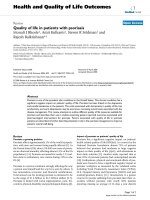Báo cáo khoa học: " Comparison of outcomes in patients with stage III versus limited stage IV non-small cell lung cancer" docx
Bạn đang xem bản rút gọn của tài liệu. Xem và tải ngay bản đầy đủ của tài liệu tại đây (267.16 KB, 7 trang )
RESEARC H Open Access
Comparison of outcomes in patients with stage III
versus limited stage IV non-small cell lung cancer
Praveena Cheruvu
1
, Su K Metcalfe
1
, Justin Metcalfe
1
, Yuhchyau Chen
1
, Paul Okunieff
2
and Michael T Milano
1*
Abstract
Background: Standard therapy for metastatic non small cell lung cancer (NSCLC) includes palliative systemic
chemotherapy and/or radiotherapy. Recent studies of patients with limited metastases treated with curative-intent
stereotactic body radiation therapy (SBRT) have shown encouraging survival. W e hypothesized that patients treated
with SBRT for limited metastases have comparable outcomes with those treated with curative-intent radiation for
Stage III NSCLC.
Methods: We retrospectively reviewed the records of NSCLC patients treated with curative-intent radiotherapy at
the University of Rochester from 2000-2008. We identified 3 groups of patients with NSCLC: stage III, stage IV, and
recurrent stage IV (initial stage I-II). All stage IV NSCLC patients treated with SBRT had ≤ 8 lesions.
Results: Of 146 patients, 88% had KPS ≥ 80%, 30% had > 5% weight loss, and 95% were smokers. The 5-year OS
from date of NSCLC diagnosis for stage III, initial stage IV and recurrent stage IV was 7%, 14%, and 27%
respectively. The 5-year OS from date of metastatic diagnosis was significantly (p < 0.00001) superior among those
with limited metastases (≤ 8 lesions) versus stage III patients who developed extensive metastases not amenable
to SBRT (14% vs. 0%).
Conclusion: Stage IV NSCLC is a heterogeneous patient population, with a selected cohort apparently faring better
than Stage III patients. Though patients with limited metastases are favorably selected by virtue of more indolent
disease and/or less bulky disease burden, perhaps staging these patients differently is appropriate for prognostic
and treatment characterization. Aggressive local therapy may be indicated in these patients, though prospective
clinical studies are needed.
Keywords: Stereotactic Body Rad iotherapy, Oligometastases, Non-Small Cell Lung Cancer
Background
Non-small cell lung cancer (NSCLC) is the leading
cause of cancer mortality in the United States [1].
Patients with stage IV NSCLC typically have a poor
prognosis, with a median survival of 8 months [2]. Pal-
liative systemic therapy improves survival and disease
control, though careful selection of patients suitable for
systemic therapy is critical. Radiation treatment for
symptomatic relief is a common approach utilized by
many clinicians.
Stage IV NSCLC represents a heterogeneous stage
grouping, with regard to the extent of disease spread,
cancer burde n (i.e. bulk), performance status, and other
prognostic factors. As previously postulated by Drs.
Hellman and Weichselbaum, the metastatic disease state
lies on a spectr um rather than occupying a finite point
[3]. Thus, the definition of metastatic disease could be
refined in terms of limited versus extensive disease
extent and/or disease bulk Patients with limited meta-
static disease and good performance have been shown
to have better outcomes following aggressive local treat-
ments, i.e. resection, stereotactic body radiotherapy
(SBRT), radiofrequency ablation [4].
In previous studies f rom the University of Rochester,
we defined oligometastases as the presence of 5 or fewer
clinically apparent metastases [5,6]. Recent studies,
including our own, suggest that patients with limited
metastases who receive curative-intent SBRT to
* Correspondence:
1
Department of Radiation Oncology, University of Rochester Medical Center,
Rochester, New York, USA
Full list of author information is available at the end of the article
Cheruvu et al. Radiation Oncology 2011, 6:80
/>© 2011 Cheruvu et al; licensee BioMed Central Ltd. This is an Open Acce ss article distrib uted und er the terms of the Creative
Commons Attribution License (http://creativecom mons.org/licenses/by/2.0), which permits unrestricted use, distribution, and
reprodu ction in any mediu m, provided the original work is properly cited.
metastatic sites, including patients with multiple organ
involvement, have encouraging survival [7,8]. SBRT
implies the us e of hypofractio nated, highly conformal
external beam radiotherapy, utilizing technology to
improv e targ eting accuracy, such as external or internal
stereotactic fiducial markers and/or image guidance.
Although data on SBRT treatment for limited metas-
tases from breast cancer and colon cancer have been
encouraging, there is limited outcome data following
SBRT for metastatic NSCLC. We hypothesized that
curative-intent SBRT for limited metastatic (i.e., select
stage IV) NSCLC results in comparable outcomes rela-
tive to stage III NSCLC treated with aggressive curative
intent treatment.
Methods
We retrospectiv ely reviewed the records of patients with
NSCLC who were treated at the University of Rochest er
from 2000-2008 wit h curative-intent radiotherapy ( with
or without chemotherapy) for stage III NSCLC or SBRT
for limited stage IV NSCLC, defined as metastatic dis-
ease treated with curative-intent. The study was
approved by the University of Rochester Research Sub-
jects Review Board.
Those patients with metastases limited in n umber
and extent, clinically determined to be amenable to
SBRT, were defined as having limited metastases.
While previ ous prospective studies from our group
[5,6] defined limited metastases/oligometastases as 5 or
fewer lesions, in this study, six NSCLC patients with
6-8 metastatic lesions were considered to have limited
metastatic NSCLC, as all radiographically apparent
lesions were amenable to SBRT as defined by our pre-
viously published normal tissue tolerances for SBRT
[9]. Several patients underwent repeat courses of SBRT
for either additional lesions or for lesions that recurred
after SBRT.
Patients with metastases from NSCLC to any organ(s),
including brain, bone, liver,orlungwereincludedin
this study. Only patients with biopsy-proven NSCLC
were included. Those with prior curative-intent treat-
ment of metastatic tumors (i.e. surgery) were not
excluded. Patients with new solitary lung lesions, q ues-
tionable for metachronous stage I NSCLC versus solitary
metastases were excluded.
The 7th AJCC Staging system was used to categorize
patients into 3 groups: those who were stage III at
initial diagnosis, those who presented with stage IV
NSCLC, and those with stage I/II NSCLC who later
developed recurrent stage IV disease. Among patient s
with Stage III NSCLC, metastatic recurrence was char-
acterized as limited metastatic (defined above) or
extensive metastatic (not amenable to curative-intent
SBRT) disease.
All patients were assessed with diagnostic CT or PET/
CT imaging to identify metastatic lesions. Brain metas-
tases were assessed with MRI. In s ome patients bone
metastases were identified with bone scan and/or MRI.
Patients who had brain metastases were treated cura-
tively with surgery and/or stereotactic radiosurgery.
Those that received surgery for brain metastases had
SBRT to other sites of metastatic disease. A variety of
chemotherapeutic or radio-sensitizing a gents were
utilized.
The net gross tumor volume (GTV) was documented
as the sum of GTVs of the primary and/or metastatic
sites. The GTVs were based on the contoured volumes
on the planning CT scan(s). Previously resected metas-
tases were not included in the net tumor volume.
ThisstudywasapprovedbytheUniversityofRoche-
ster Research Subjects Review Board.
Conventional Radiotherapy
Stage III patients underwent a CT sim ulation for treat-
ment planning purposes. D efinitive radiotherapy was
given concurrently with chemotherapy or as adjuvant
treatment following surgery. A 3D conformal technique
was utilized to shape the dose around the tumor volume
with an appropriate volumetric expansion. The average
dose prescribed was 60 Gy but ranged from 45 to 66
Gy.
SBRT Technique
SBRT was delivered through the Novalis Exac Trac
®
System. All patients were immobilized during simulation
and treatment using a vacuum cushion device. An end-
expiratory or shallow b reath-hold technique was used in
conjunction with the ExacTrac
®
patient positioning plat-
form (BrainLAB
®
, AG, Heimst ett en, Germany) to accu-
rately reproduce patient set-up during treatments. The
ExacTrac
®
system consists of external body fiducial
markers monitored in real time by two ceiling mounted
infrared cameras. Treatment planning was performed
with BrainLAB planning software. SBRT was delivered
using conformal arcs, and the dose was prescribed to
the isocenter with the 80% isodose line covering the
planning target volume (PTV). The treatment volume
included a 7-10 mm v olume tric expansion of the GTV.
Typically, the dose schedule was 50-60 Gy in 5-10 frac-
tions. Depending on the location of the lesion and the
dose volume histogram of the organs at risk, a more
hypofractionated schedule was utilized in 5 fractions.
Our institution has adapted a 10 fraction scheme of
treating patients with SBRT to reduce potential toxicity
while preserving control. Typically peripheral lung
lesions were treated with 5 fractions to 50 Gy, while
more central lung lesions, adrena l, liver, abdominal/pel-
vic lymph node metastases were treated with 10 fr ac-
tions to 50 Gy.
Cheruvu et al. Radiation Oncology 2011, 6:80
/>Page 2 of 7
Endpoints
The primary endpoint was overall survival (OS). OS was
calculated in two manners: from the date of initial
NSCLCdiagnosis,aswellasfromthedateoffirst
metastases, to date of last follow-up or death, using
Kaplan-Meier actuarial survival analyses. OS was mea-
sured from date of initial diagnosis to compare out-
comes of limited stage IV and Stage III NSCLC patients.
As an alternate measure of OS, the date of first metas-
tases was used as a reference point to compare the out-
comes of recurrent metastatic patients versus those who
presented with initial limited metastatic disease. Univari-
ate analyses (UVA) were performed with log-rank tests
(for discrete variables ) or Cox regression analyses (for
continuous variables). Significant (p ≤ 0.05) variables on
UVA were tested with multivariate analyses (MVA),
using a C ox propo rtional hazards regression model. Chi
square tests a nd ANOVA tests were used to compare
patient and tumor characteristics between the sub-
groups. Stata version 9.2 w as used for all data analyses.
The retrospective nature of this study did not allow for
detailed assessment of treatment toxicity; previous
repo rts from our gro up have suggested minimal adverse
effects after SBRT [10,11].
Results
Patient and disease characteristics
Patient and disea se characteristics are summarized in
Additional file 1. From 2000- 2008, 146 pa tients were
eligible for analysis. Patient age ranged from 35 - 85
years (median 65 years). Eighty-eight percent had Kar-
nofsky performance status (KPS) ≥ 80%, and 30% had >
5% weight loss at time of diagnosis. The majority of
patients (95%) had a prior smoking history. One-hun-
dred patients received chemotherapy during the course
of their cancer tre atment, and 22 patients underwent
prior resection of their primary lung mass. Thirteen
patients had curative resection o f a metastatic lesion
prior to their course of SBRT. Metastatic sites apparent
at the time of SBRT for limited metastases included
lung or thoracic lymph nodes (n = 22), liver (n = 13),
adrenal glands (n = 16), bone (n = 7), retroperitoneal
lymphnode(n=2),andCNS(n=10).Thirteen
patients developed brain metastases at the time of
extensive metastatic progression (n = 13). The net GTV
ranged from 0.9 - 877.1 ml (median 85.7 ml). Compared
to stage III patients, those with initial limited Stage IV
disease had less bulkier disease (median 93. 9 ml vs. 76.5
ml respectively), though not significant (p = 0.27; Addi-
tional File 1).
There were a total of 94 patients (64.3%) categorized
as stage III NSCLC, 38 patients (26.0%) with initial lim-
ited stage IV NSCLC and 14 patients (9.6%) with stage
I/II NSCLC who progressed to limited metastatic stage
IV. Fifty-five of the 94 patients with initial stage III
NSCLC (74%) developed radiographically apparent
metastases, of whom 44 developed limited metastatic
stage IV disease (all with ≤5 lesions), treated with SBRT.
The average time to recurrence for these Stage III
patients was 14.2 months (range 3.2-45.2 months).
Among those with Stage III and Stage IV disease all had
a staging CT or MRI of head. All 38 patients with stage
IVNSCLChadPET/CTwhile90of93patientswith
stage III NSCLC had PET/CT.
Outcomes
The OS calculated from time of initial NSCLC diagnosis
is presented in Additional file 2 and Figure 1. The 2-
year and 5-year OS for all patients with stage III
NSCLC was 43% and 7% respectively versus 43% and
14% for initial limited stage IV (p = 0.30).
The OS calculated from the date of diagnosis of meta-
static disease is presented in Additional file 3 and Figure
2. Worse survival was observed in patients with initial
stage I/II or Stage III NSCLC who developed metastases
(5-year OS 0%, with no survivors beyond 4.1 years) ver-
sus those who initially presented with limited metastatic
disease (5-year OS 14%, p = 0.003).
Among those with recurrent stage IV NSCLC (stage I/II,
or III who progressed to stage IV) the patients who
developed limited metastases had a 2-year and 5-year
OS from date of metastatic progression of 25% and 0%
respectively. In contrast, there were no survivors beyond
11.0 months among the 14 patients with stage I/II or III
NSCLC who developed extensive metast atic disease (p <
0.00001). For patients with initial diagnosis of limi ted
stage IV NSCLC, there was no significant difference
among patients with ≤ 5 metastases versus 6-8 (p =
0.94).
Age, KPS, weight loss, smoking history, stage and net
GTV were assessed for affect on OS from date of initial
NSCLC diagnosis as shown in Additional file 4. On uni-
variateanalysisofOSfromdateofinitialNSCLCdiag-
nosis, GTV at time of radiation for initial stage III or IV
NSCLC (p < 0.002) was the only variable which was sta-
tistically. Stage III versus limited metastatic Stage IV
trended (p = 0.078) towards worse OS. MVA models for
OS were also assessed with the same variables; net GTV
remained a statistically significant (p = 0.001) factor for
predicting OS. MVA using only stage and GTV did not
change the results. MVA models for OS from date of
metastases treated with SBRT were assessed, with the
same variables. Net GTV of metastases treated with
SBRT was not statistically significant (p = 0.39).
Discussion
The standard treatment for metast atic NSCLC is
systemic therapy. However, in those patients with
Cheruvu et al. Radiation Oncology 2011, 6:80
/>Page 3 of 7
Figure 2 represents the overall survival from date of failure. The blue line represents Stage III which progressed to Stage IV, green line
represents the Stage I/II patients that progressed to Stage IV, and lastly the maroon line represents initial stage IV patients.
Figure 1 represents the overall survival from date of diagnosis for the various stage groupings. The blue line represents Stage III (whom
did not progress to Stage IV, maroon line represents Stage III which progressed to Stage IV, green line represents the initial stage IV patients
and lastly the gold line represents the Stage I/II patients that progressed to Stage IV.
Cheruvu et al. Radiation Oncology 2011, 6:80
/>Page 4 of 7
metastases limited in number and location, local surgical
or ablative treatments have shown to be beneficial. Ser-
ies describing surgical metastectomy have the largest
patient numbers and longest follow up [12-14]. Surgical
metastatectomy is proposed to be a curative therapy,
resulting in prolonged disease-free survival [15].
Recently, there is an expanding experience with stereo-
tactic radiotherapy as effective local therapy for meta-
static lesions from any primary cancer. Local control
rates of 60-90% have been reported for metastatic
tumors involving spine, lung, and liver [16-20].
In this study, patients with initial stage IV NSCLC
treated with aggressive local therapy had a higher 5-year
OS when compared to stage III NSCLC patients treated
with curative intent (14% and 7%, respectively).
Although our 5-year survival rate of 7 % for Stage III
NSCLC patients is lower than what is reported in Phase
II-III studies of definitive radiation, our Stage III
patients represent an unselected cohort of all patients
seen in our clinic, many of whom had adverse prognos-
tic factors such as poor performance status and/or sig-
nificant weights loss, unlike most patients receiving
chemoradiation/radiation on prospective studies [21,22].
Most of our patients with Stage III NSCLC had bulky
disease, and many would not qualify for prospective stu-
dies because of poor performance status and/or > 5%
weight loss (Additional file 1). The 5-year OS rate of
patients presenting with limited stage IV NSCLC, which
is a selected cohort of patients with disease amenable to
SBRT, was similar to those w ith stage III NSCLC that
did not metastasize, suggesting that a number of
patients in AJCC stage IV group would be more appro-
priately classified as stage III NSCLC in future AJCC
staging.Thesedatasupportthehypothesisthatselect
patients with stage IV NSCLC have excellent outcomes
comparable to unselected patients with stage III disease
when treated aggressively with SBRT.
Patients with initial limited stage IV NSCLC fared bet-
ter than those with stage I/II or III NSCLC who later
progressed to stage IV (5-year OS 22% versus 0% from
time of metastatic diagnosis). Perhaps limited metastases
presenting as Stage IV NSCLC is biologically more
responsive to cancer therapy than recurrent disease.
There may be a period during which local therapy
may be most beneficial for patients who initially present
with limited metas tatic disease. Studies have shown that
effective chemotherapy can reduce the number and sites
of metastatic tumors at which time, local therapy may
be considered [23-25]. Rusthoven et al reporte d that
after NSCLC patients receive systemic chemotherapy for
limited metastases, the majority (64%) progressed with
local failure only; the time to progression in these
patients was 3 - 4 months, thereby providing a critical
window during which curative local therapy could be
offered. Researchers from the University of Chicago
analyzed the patterns of recurrence among 38 patients
with stage IIIB and IV NSCLC who were enrolled on a
Phase II trial of oxaliplatin and paclitaxel [24]. Half of
the p atients (19/38) had stable disease or progressed in
the original sites only without developing new lesions
after the completion of chemotherapy. Seventeen
patients who had limited disease (≤ 4 metastatic sites) at
initial presentation had a higher propensity to have
stable disease or progress only at the initially involved
sites. These studies demonstrate that there is a point at
which progression of metastatic disease (i.e., develop-
ment of new lesions) may be suppressed by syste mic
chemotherapy, allowing for aggressive local treatment to
address residual disease.
The role of combined modality treatment for meta-
static NSCLC patients was investigated by Khan, et al in
a retrospective series of 23 patients with oligometastatic
(1-2 sites) NSCLC disease [25]. These patients received
curative treatment for their primary thoracic disease and
subsequently received local tre atment for their meta-
static sites. At 28 months, overall survival was 22% with
median survival of 20 months. In our study, patients
with initial limi ted metastatic NSCLC treated with
SBRT had a 2-year OS of 48% - this difference could be
attributed to differences in patients or cancer character-
istics or perhaps recent improvements in systemic che-
motherapy and local treatment techniques. With a
combined modality approach, the potential for further
metastatic disease dissemination may be minimized,
thus potentially translating to improved OS.
Among patients with recurrent metastatic NSCLC,
those with limited metastases (2-year survival of 24%)
had superior outcomes compared to those with exten-
sive disease (no survivors beyond 11.0 months). This is
consistent with the hypothesis that a larger tumor bur-
den may predict for increa sed risk of local failure and
metastatic potential. Among patients with li mited
metastases treated with curative intent SBRT, there were
not significant differences in survival between those with
≤ 5 metastases versus 6-8 metastases, and in fact their
survival is equivalent at 47 months. While small patient
numbers limit analyses, this suggests that other variables
such as tumor bulk and/or tumor location are more cri-
tical than number of lesions. Previous studies from our
group of patients who underwent SBRT for limited
metastases (not necessarily from NSCLC) [10,11,26]
have shown net GTV to significantly impact disease
control and survival outcomes.
In patients with non-metastatic NSCLC, numerous
studies suggest that tumor burden corr elates with prog-
nosis [27-30]. In a small cohort of 19 patients with stage
I-III NSCLC, Lee et al reported that tumor volume > 25
cc measured on PET CT scan was associated with
Cheruvu et al. Radiation Oncology 2011, 6:80
/>Page 5 of 7
increased risk of disease progression and was postulated
to be a poor prognostic factor in lung cancer. Similarly,
Bradley et al. demonstrated the prognostic value of
GTV determined on planning CT scans to be associated
with OS and local tumor control. This correlation
appears to persist for patients with metastatic NSCLC
[31] as reported by Oh et al and our present observa-
tions in which net GTV predicted for improved OS
(MVA p < 0.0001). However, GTV of metastatic sites
treated with SBRT was not significantly correlated with
OS. The GTV of metastatic sites included patients with
initial Stage III who developed limited metastases.
Weaknesses of our study include the retrospective
nature of the analyses, heterogeneity of patient treat-
ment, including various systemic therapy regimens
(which was not presented), heterogeneity of involved
metastatic sites (which was not analyzed) and, for some
patient subgroups, r elatively small patient numbers.
Strengths of our study include an overall relativ ely large
study population (particularly unselected Stage III
patients and select patients with limited metastases
from NSCLC) allo wing for the analysis of several prog-
nostic variables.
Stage IV NSCLC represents a heterogeneous patient
population. Those patients with limited tumor burden
in terms of volume and number of lesions are amenable
to, and may benefit from focal ablative therapy to
known sites of disease. In our study, select patients with
limited stage IV NSCLC treated with curative-intent
SBRT, have similar outcomes compared to those unse-
lected patients with stage III NSCLC. While the benefit
of SBRT (or other ablative therapies) for limited meta-
static NSCLC has not been definitively proven from
controlled randomized studies, even with the possibility
of no benefit from ablative therapies, select patients
with Stage IV NSCLC fare relatively well, and perhaps
warrant unique consideration in future AJCC stage
groupings. It reasonable to postulate that these patients
fare well by virtue of a less indolent disease process in
conjunction with a therapeutic benefit from ablative
therapy. Given the relatively poor prolonged NSCLC
disease control from systemic therapy, it is difficult to
postulate that ablative therapies are not benefiting
patients. Nonetheless, the favorable outcomes reported
here warrant consideration of further investigation of
local treatment for patients with limited tumor burden.
The University of Chicago has launched a randomized
Phase II trial of patients with 1-5 metastases from
NSCLC to assess the survival with the addition of hypo-
fractionated image guided radiotherapy concurrently
with docetaxel and cisplatin. The NCCTG is also rando-
mizing patients with 1-5 metastases from NSCLC, to
undergo or not undergo radiation (with standard fractio-
nation) to metastatic sites.
Conflicts of Interest Notification
The authors declare that they have no competing
interests.
Additional material
Additional file 1: Table S1- patient characteristics.
Additional file 2: Table S2 - overall survival from date of diagnosis.
Additional file 3: Table S3 - overall survival from date of
metastases.
Additional file 4: Table S4 - univariate & multivariate analysis for os
from date of initial nsclc diagnosis.
Author details
1
Department of Radiation Oncology, University of Rochester Medical Center,
Rochester, New York, USA.
2
Department of Radiation Oncology, University of
Florida’s College of Medicine, Gainesville, Florida, USA.
Authors’ contributions
PC and SM participated in creation of database and input of data. PC
drafted manuscript. JM and PEC performed the statistical analysis. YC, PO
and MT treated the patients on study. MT participated in design of study
and coordination and helped to draft the manuscript. All authors read and
approved the final manuscript.
Received: 4 April 2011 Accepted: 30 June 2011 Published: 30 June 2011
References
1. Jemal A, Siegel R, Xu J, Ward E: Cancer Statistics, 2010. CA Cancer J Clin
2010, 60(5):277-300, Epub 2010 Jul 7.
2. Greene FL, Page DL, Fleming ID, Fritz A, Balch CM, Haller DG, Morrow M:
AJCC Cancer Staging Manual. New York: Springer;, 6 2002.
3. Hellman S, Weichselbaum RR: Oligometastases. J Clin Oncol 2005, 13:8-10.
4. Timmerman RD, Bizekis CS, Pass HI, Fong Y, Dupuy DE, Dawson LA, Lu D:
Local Surgical, Ablative and Radiation Treatment of Metastases. CA
Cancer J Clin 2009, 59:145-170.
5. Milano M T, Katz A W, Muhs AG, Philip A, B uchholz DJ, S chell MC, O kunieff P: A
Prospective Pilot s tudy of Curative Intent Stereotactic Body Radiotherapy in
Patients with 5 or fewer Oligomet astatic Lesions. Cancer 2008, 112:650-658.
6. Milano MT, Katz AW, Schell MC, Philip A, Okunieff P: Descriptive Analysis of
Oligometastatic Lesions Treated with Curative-Intent Stereotactic Body
Radiotherapy. Int J Radiat Oncol Biol Phys 2008, 72(5):1516-22.
7. Kao J, Packer S, Vu HL, Schwartz ME, Sung MW, Stock RG, Lo YC, Huang D,
Chen SH, Cesaretti JA: Phase 1 Study of Concurrent Sunitinib and Image
Guided Radiotherapy followed by Maintenance Sunitinib for Patients
with Oligometastases: Acute Toxicity and Preliminary Response. Cancer
2009, 115(15):3571-80.
8. Salama JK, Chmura SJ, Mehta N, Yenice KM, Stadler WM, Vokes EE, Haraf DJ,
Hellman S, Weichselbaum RR: An Initial Report of Radiation Dose-
Escalation Trial in Patients with One to Five Sites of Metastatic Disease.
Clin Cancer Res 2008, 14(160):5255-9.
9. Milano MT, Constine LS, Okunieff P: Normal Tissue Toxicity after Small Field
Hypofractionated Stereotactic Body Radiation. Radiat Oncol 2008, 3:36.
10. Katz AW, Carey-Sampson M, Muhs AG, Milano MT, Schell MC, Okunieff P:
Hypofractionated Stereotactic Body Radiation Therapy (SBRT) for Limited
Hepatic Metastases. Int J Radiat Oncol Biol Phys 2006, 67:793-798.
11. Okunieff P, Petersen AL, Philip A, Milano MR, Katz AW, Boros L, Schell MC:
Stereotactic Body radiation Therapy (SBRT) for Lung Metastases. Acta
Oncol 2006, 45:808-817.
12. Choti MA, Sitzmann JV, Tiburi MF, Sumetchotimetha W, Rangsin R,
Schulick RD, Lillemoe KD, Yeo CJ, Cameron JL: Trends in Long-Term
Survival Following liver resection for Hepatic Colorectal Metastases. Ann
surg 2002, 235:759-766.
13. Sternberg DI, Sonett jr: Surgical Therapy of Lung Metastases. Semin Oncol
2007, 133:967-972.
Cheruvu et al. Radiation Oncology 2011, 6:80
/>Page 6 of 7
14. Tanvetyanon T, Robinson L, Schell MJ, Strong VE, Kapoor R, Coit DG,
Bepler G: Outcomes of Adrenalectomy for Isolated versus Metachronous
Adrenal Metastases in Non-Small- Cell Lung Cancer: A Systematic
Review and Pooled Analysis. J Clin Oncol 2008, 26:1142-1147.
15. Pfannschmidt J, Dienemann H: Surgical Treatment of Oligometastatic
Non-Small Cell Lung Cancer. Lung Cancer 2010, 69:251-258.
16. Rusthoven KE, Kavanagh BD, Burri SH, Chen C, Cardenes H, Chidel MA,
Pugh TJ, Kane M, Gaspar LE, Schefter TE: Multi-institutional phase I/II trial
of stereotactic body radiation therapy for lung metastases. J Clin Oncol
2009, 27:1579-1584.
17. Kavanagh BD, McGarry RC, Timmerman RD: Extracranial Radiosurgery
(Stereotactic Body Radiation Therapy) for Oligometastases. Semin Radiat
Oncol 2006, 16(2):77-84.
18. Lo SS, Sahgal A, Wang JZ, Mayr N A, Sloan A, Mendel E, C hang EL: Stereotactic
Body Radiation Therapy for Spinal Metastases. Discov Med 2010, 9(47):289-96.
19. Rusthoven KE, Kavanaugh BD, Cardenes H, Stieber VW, Burri SH,
Feigenberg SJ, Chidel MA, Pugh TJ, Franklin W, Kane M, Gaspar LE,
Schefter TE: Multi-institutional Phase I/II Trial of Stereotactic Body
Radiation Therapy for Liver Metastases. J Clin Oncol 2009, 27(10):1572-8.
20. Chang EL, Shiu AS, Mendel E, Mathews LA, Mahajan A, Allen PK,
Weinberg JS, Brown BW, Wang XS, Woo SY, Cleeland C, Maor MH,
Rhines LD: Phase I/II study of stereotactic body radiotherapy for spinal
metastasis and its pattern of failure. J Neurosurg Spine 2007, 7:151-60.
21. Curran WJ, Scott CB, Langer CJ, Komaki R, Lee S, Hauser S, Movsas B,
Wasserman T, Sause W, Cox JD: Long-term benefit is observed in a phase
III comparison of sequential vs concurrent chemo-radiation for patients
with unresected stage III NSCLC: RTOG 9410. Proc Am Soc Clin Oncol
(ASCO) Chicago; 2003, , abstr. #2499: 621.
22. Gandara DR, Chansky K, Albain KS, Leigh BR, Gaspar LE, Lara PN, Burris H,
Gumerlock P, Kuebler JP, Bearden JD, Crowley J, Livingston R:
Consolidation Docetaxel After Concurrent Chemoradiotherapy in Stage
IIIB Non-Small-Cell Lung Cancer: Phase II Southwest Oncology Group
Study S9504. JCO 2003, 21(10):2004-2010.
23. Rusthoven KE, Hammerman SF, Kavanagh BD, Birtwhistle MJ, Stares M,
Camidge DR: Is there a Role for Consolidative Stereotactic Body Radiation
Therapy Following First-Line Systemic Therapy for Metastatic Lung
Cancer? A Patterns-of-Failure Analysis. Acta Oncologica 2009, 48:578-583.
24. Mehta N, Mauer AM, Hellman S, Haraf DJ, Cohen EE, Vokes EE,
Weichselbaum RR: Analysis of Further Disease Progression in Metastatic
NSCLC: Implications for Locoregional Treatment. Int Journal of Oncology
2004, 25:1677-1683.
25. Khan AJ, Mehta PS, Zusag TW, Bonomi PD, Penfield Faber L, Shott S,
Abrams RA: Long term Disease Free Survival Resulting from Combined
Modality Management of Patients Presenting with Oligometastatic
NSCLC. Radiotherapy and Oncology 2006, 81:163-167.
26. Chawla S, Chen Y, Katz AW, Muhs AG, Philip A, Okunieff P, Milano MT:
Stereotactic Body Radiotherapy for Treatment of Adrenal Metastases. Int
J Radiat Oncol Biol Phys
2009, 75(1):71-5.
27. Lee P, Weerasuriya DK, Lavori PW, Hara W, Maxim PD, Le QT, Wakelee HA,
Donington JS, Graves EE, Loo BW: Metabolic Tumor Burden Predicts for
Disease Progression and Death in Lung Cancer. IJROBP 2007,
69(2):328-333.
28. Bradley J, Ieumwananonthachai N, Purdy JA, Wasserman TH, Lockett MA,
Gramham MV, Perez CA: Gross Tumor Volume Critical Prognostic Factor
in Patients Treated with Three Dimensional Conformal Radiotherapy for
NSCLC. IJROBP 2002, 52(1):49-57.
29. Basaki K, Abe Y, Aoki M, Kondo H, Hatayama Y, Nakaji S: Prognostic factors
for survival in Stage III non-small-cell-lung cancer treated with definitive
radiation therapy: impact of tumor volume. IJROBP 2006, 64:449-454.
30. Nishio W, Sakamoto T, Uchino K, Yuki T, Nakagawa A, Tsubota N: Effect of
Tumor Size on Prognosis in Patients with Non Small Cell Lung Cancer:
the Role of Segmentectomy as a Type of Lesser Resection. J Thoracic
Cardiovasc Surg 2005, 129:87-93.
31. Oh Y, Taylor S, Bekele BN, Debnam JM, Allen PK, Suki D, Sawaya R,
Komaki R, Stewart DJ, Karp DD: Number of Metastatic Sites is a Strong
Predictor of Survival in Patients with Nonsmall Cell Lung Cancer With or
Without Brain Metastases. Cancer 2009, 115:2930-2938.
doi:10.1186/1748-717X-6-80
Cite this article as: Cheruvu et al.: Comparison of outcomes in patients
with stage III versus limited stage IV non-small cell lung cancer.
Radiation Oncology 2011 6:80.
Submit your next manuscript to BioMed Central
and take full advantage of:
• Convenient online submission
• Thorough peer review
• No space constraints or color figure charges
• Immediate publication on acceptance
• Inclusion in PubMed, CAS, Scopus and Google Scholar
• Research which is freely available for redistribution
Submit your manuscript at
www.biomedcentral.com/submit
Cheruvu et al. Radiation Oncology 2011, 6:80
/>Page 7 of 7









